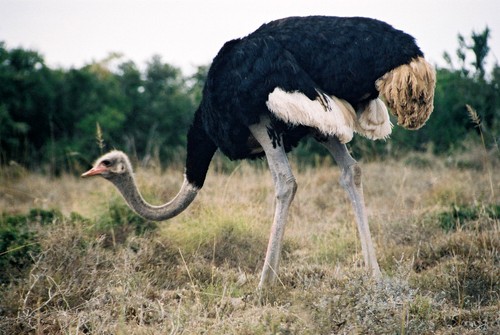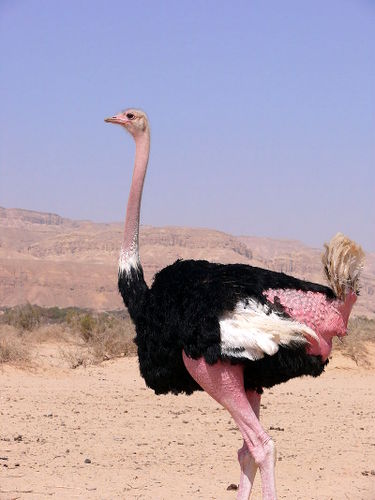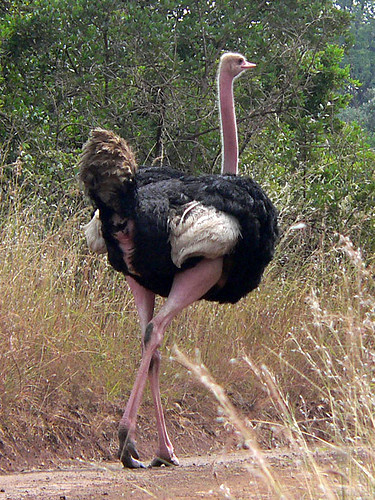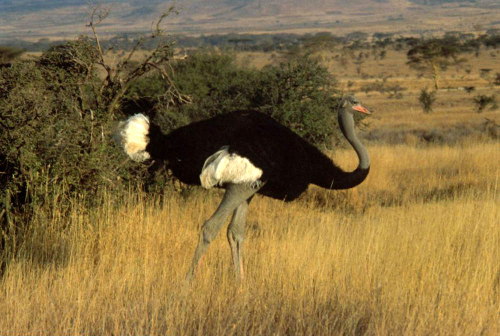Ostrich Hunting
There are several subspecies of ostrich throughout Africa displaying variations in colour of plumage, legs and necks.
Huntable Ostrich Species
For most hunters an ostrich is an ostrich but just in case you are an ostrich connoisseur, hoping to get the ostrich grand slam, there are 4 huntable ostriches in Africa.
- Southern Ostrich - Struthio camelus australis
- North African or Red-necked Ostrich - Struthio camelus camelus
- Masai Ostrich - Struthio camelus massaicus
- Somali Ostrich - Struthio camelus molybdophanes
Where To Hunt An Ostrich
- You can hunt a southern ostrich on private game ranches in Botswana, South Africa and Namibia.
- There is an overlap of 3 different ostrich subspecies in East Africa. In Ethiopia you can hunt the north African ostrich in the north-west, Masai ostrich in the south and Somali ostrich in the north-east.
- In Tanzania you can hunt a male Masai ostrich on a 21 day licence in Masailand.
Which Ostrich is Which?
Click image to enlarge
 Southern Ostrich
Southern Ostrich North African Ostrich
North African Ostrich Masai Ostrich
Masai Ostrich Somali Ostrich - When in breeding trim, the legs & neck turn bright blue
Somali Ostrich - When in breeding trim, the legs & neck turn bright blueOstrich Hunting Prices
- In Botswana the trophy fee on a southern ostrich is between US$300 and US$800.
- In Namibia the trophy fee for a southern ostrich is between US$400 and US$850.
- In South Africa the trophy fee for a southern ostrich is between US$300 and US$700.
- In Ethiopia, all the ostrich subspecies have a trophy fee of US$1600.
- In Tanzania the Government trophy fee for a Masai ostrich is US$1200. When the Community Development/anti-poaching fees are added, the trophy fee will be between US$1300 and US$1500.
Ostrich Hunting Methods
- Ostriches are really hunted as animals of opportunity. They are often hunted as an easy, fun diversion from hunting another animal which frequently turns into a real hard battle of wits, endurance and a lot of ammo. This bird has exceptionally good eyesight and hearing, plus of course it can run at incredible speed.
- You really need to be able to quietly stalk an ostrich from positions of cover. If sees or hears you, the ostrich will be off like a race horse. It is even harder if the ostrich is in a flock.
- Like with any animal, once the ostrich is down, it is important to approach from behind as the ostrich can pack a powerful forward kick.
A Good Ostrich Trophy
- A mature male ostrich preferably.
Ostrich Hunting Shot Placement
- Remember that they are not as big in the body as they look and that a very large part of what you see is nothing but feathers.
- With the animal standing at right angles to you, the heart can be found by drawing that imaginary line up the foreleg and dividing the body in half and half again and where the lowermost line and foreleg line cross, you'll find the heart.
- Apply the same rule to the frontal chest shot and you'll also find the heart.
- Other options are the neck shot and the head shot, but both of these are small targets and liable to do serious damage to the trophy.
- The 'Texas Heart Shot' is also very effective on ostrich.
Male Ostrich Vital Statistics
- Height: 2.1-2.8m / 6'11"-9'2"
- Weight: 139-320lbs / 63-145kg
Ostrich Habitat and Requirements
- These birds prefer dry open savanna areas and are quite happy in semi-deserts or true deserts.
- Ostriches can go without drinking for several days.
Ostrich Social Structure
- They live in nomadic groups of five to 50 birds (led by a top hen) that often travel together with other other grazing animals like zebra.
Ostrich Reproduction
- Ostriches lay about 25-30 eggs which hatch after about 45 days.
Ostrich Gender Identification
- Mature males have predominantly black plumage with white primary feathers and tail with almost bare skin on the legs and neck. The females have brown/grey plumage.
- Males are generally taller than females.
- During courtship the males legs and neck turn a brighter colour of orange or red, depending on the subspecies. The Somali ostrich legs and neck go bright blue.
Ostrich Trophy Permits (2015)
There are other ostrich subspecies in west and central Africa which are CITES I and not on quota to be hunted. If you buy or find an ostrich egg or feathers you wish to keep as a souvenir from these countries, you must get a CITES export, CITES import permit and veterinary clearance.
All ostrich hunting trophy products, including loose feathers and eggs, being exported from ostrich hunting countries must be treated and have veterinary clearance to prevent the spread of avian disease.
| All Huntable Ostrich |
CITES |
USF&W |
EU |
AUS |
| N/A |
N/A |
N/A |
N/A |
Ostrich Trophy Taxidermy
What to do with an ostrich trophy? Well, you could go for a full mount if you have space. If not, you could have a shoulder or half mount, retaining the very unusual feet as a lamp stand or bookends.
Click images to enlarge
Ostrich Hunting Recommended Reading
Home Life On An Ostrich Farm by Annie Martin (1890). The author accompanied her husband to South Africa in 1881 and they resided there for several years engaged in ostrich farming. There is a good deal of information on the subject of ostrich breeding. It includes an interesting account of a wounded buffalo attacking a hunter's horse, a springbok hunt in the Karoo region and additional mention of hunting leopards and baboons. Free eBook
Hunting Other African Animals
Big Five Hunting
Waterside Hunting
Other Plains Game Hunting
Spiral Horned Antelope Hunting
Large Antelope Hunting
Medium Antelope Hunting
Small Antelope Hunting
African Pig Hunting
Other Cat Hunting
Animals Of Opportunity

